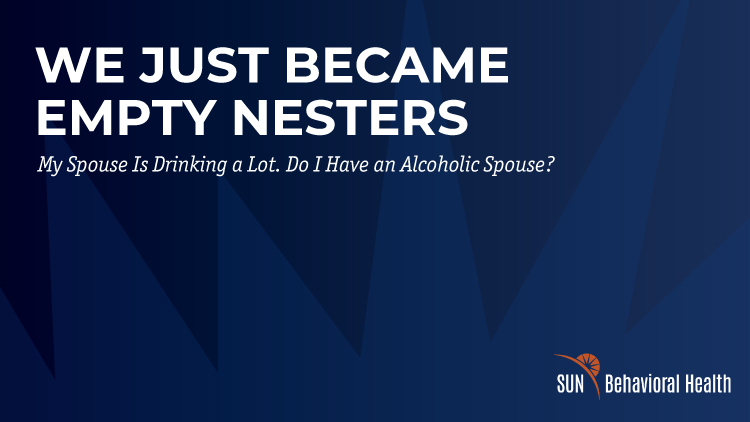Menu
close
24 Hour Crisis Care
Services

Kids grow up so fast, don’t they? It feels like just yesterday they were learning how to walk, and now the last one is on their way to college. This is such a bittersweet moment because you have the house to yourself now, but there’s also way more idle time. Unfortunately, some people fill that idle time with drinking.
You’ve probably noticed that your husband is indulging in beer and liquor a little more frequently than before, and you’re scared that this could turn into alcohol use disorder, more commonly known as alcoholism. We will discuss what you can do in this case, the definition of alcohol use disorder, and what to do for alcohol addiction treatment.
This is something plenty of empty nester parents go through. Empty nest syndrome is that feeling of grief and sadness when your final child leaves home.
While this isn’t a clinical diagnosis, studies have shown that the effect on empty nesters can be strong. Some empty nesters in the past have dealt with marriage problems, depression, and alcohol use disorder.
According to the University at Buffalo Clinical and Research Institute on Addictions, about 25% of married couples have a husband who drinks regularly (i.e., at least once per month or more) while the wife doesn’t, and about 12% of couples have a husband who drinks heavily. Unfortunately, this holds several consequences. For example, heavy drinking, alcohol use disorder and other alcohol related problems are associated with lower marital satisfaction.
Couples where one spouse has an alcohol use disorder also experienced more negative reactions than other couples, and alcohol/substance use is one of the most common reasons of divorce (third most common for women and eighth most common for men) These occurrences are rough, but you are not alone.
You are not alone. So many others have felt like they are lost, like they can’t help their spouse any more, like they want to get divorced so their spouse will get their life together. There are support groups that can help people whose spouses struggle with AUD:

Alcohol use disorder (AUD) occurs when someone feels like they can’t control their patterns of drinking alcohol. This can mean that a person drinks alcohol instead of going out with friends, needs to drink more alcohol in order to get the same effect of happiness, and continues to drink even if it is causing distress.
Alcohol use disorder can have varying levels (mild, moderate, and severe). There are certain criteria to determine what “type” of AUD someone is suffering from. These criteria are found in the following list of questions from the “Diagnostic and Statistical Manual of Mental Disorders, Fifth Edition” and are used to assess whether a person has AUD.
In the past year, have you:
If you answered “yes” to two or three of these, then you may have mild AUD; four to five would be moderate AUD; and six or more would be severe AUD. Someone with AUD is also more likely to binge drink.
Binge drinking is a dangerous form of alcohol consumption where a person drinks over the recommended average within two hours. For men, this would be having five or more alcoholic beverages in that time frame, and for women, it would be four or more.
Binge drinking is very common as one in six adults binge drinks about four times per month, consuming about seven drinks per binge. This equates to about 467 binge drinks per year per person binge drinking. The most binge drinks are consumed by those who are ages 35 and up, which includes most empty nesters.
While someone binge drinking doesn’t necessarily mean that they have AUD, it is still a dangerous practice that can lead to AUD. Binge drinking increases the risk of accidental injuries such as falls and burns, and can even lead to chronic diseases such as:
Binge drinking can also lead to certain cancers. It can cause cancer of the liver, the colon, the esophagus, and the mouth.
There are several long-term effects of alcohol use disorder. AUD can affect different parts of your body, one of them being the brain. Alcohol already affects the brain initially due to it interfering with communication pathways in the brain, but AUD can cause significant brain damage and may lead to Wernicke-Korsakoff syndrome (WKS). This is a syndrome made up of two different conditions: Wernicke’s encephalopathy and Korsakoff’s psychosis. The symptoms of Wernicke’s encephalopathy are:
The symptoms of Korsakoff’s psychosis include:
AUD can affect the heart as well as it can cause coronary heart disease, high blood pressure, stroke, and an irregular heartbeat. It can also lead to cardiomyopathy, which is when the heart itself stretches out and drops down from where it is supposed to be in your body.
AUD also takes a major toll on the liver, often leading to alcoholic cirrhosis.
Cirrhosis is a disease that attacks the liver. When the liver is injured, it repairs itself. During that repair, scar tissue forms. During cirrhosis, that scar tissue keeps forming to the point where the liver stops repairing itself. This means that the liver can’t do its job properly (process alcohol and break down fat). This can be life-threatening. Symptoms show up in later stages of cirrhosis, and they include:
SUN Behavioral Delaware is here for your spouse, no matter how severe their AUD may be. Every patient is different, which is why we have several different options for alcohol addiction treatment.
We understand that you may have other obligations outside of recovery. While the kids are out of the house, you may still need to provide for your spouse and keep the kids in the University of Delaware. This is why we offer outpatient rehab for adults.
A partial hospitalization program (PHP) is a type of treatment where a patient will be attending the treatment facility for five group therapy sessions per day five times a week but will still live at home. This is ideal for someone who is transitioning from inpatient treatment (where the patient stays on-site at the facility). In PHP, patients will be attending groups that focus on coping skills training, WRAP (Wellness Recovery Action Plan) that helps with relapse prevention, and cognitive behavioral therapy.
In our intensive outpatient program (IOP), you will be attending the facility for treatment but will go home afterward. Patients will attend three group sessions per day, five days a week, and these sessions will include therapy, relapse prevention, and a daily process group to work through different stressors in life.
We also have an evening adult IOP or those 18 and older, and sessions take place from 6 p.m. to 9 p.m. on Mondays, Wednesdays, and Thursdays.
Some of the key components of our outpatient program include:
Known as the gold standard of psychotherapy, cognitive behavioral therapy (CBT) is a form of therapy that focuses on restructuring a patient’s thinking patterns. The goal is to make the patient aware of their negative thought process and learn how to view challenging situations more clearly.
CBT has been used for multiple mental disorders (depression, anxiety, PTSD) but also works well for addiction. CBT aims to change thinking patterns and behavioral patterns. According to the American Psychological Association (APA), to change behavioral patterns, CBT uses these strategies:
CBT also uses these strategies to change thinking patterns, according to the APA:
CBT encourages people to use its practices outside of the therapy session. Yes, CBT has homework. The purpose of this homework is so patients can get better at using their coping skills. For example, reading something about feelings can help you understand yourself better, while role-playing will help you prepare for an interaction with someone else. This homework will make sure you are ready for the different tests that will come your way, and it will benefit you in the long run.
Addiction can be lonely. It feels like you are the only one struggling with it. You are not alone. There are other people having the same battle with alcohol that you are, and group therapy highlights this.
Group therapy shows patients that addiction is common and helps to weaken the stigma (negative and unfair beliefs) people with AUD often face. Group therapy provides a great support system for each patient as they can help each other with different struggles. For example, maybe an older patient has gone through empty nest syndrome before and can provide insight on how they worked through that feeling.
One of the strengths of group therapy is that it helps patients with interpersonal skills. Interpersonal skills are learning when to talk, how to listen, and how to maintain self-respect when asking for what you want. These skills are a great way to integrate patients back into society.
Group therapy is also helpful due to the diversity of patients. The diversity of group therapy members shows how many people from all walks of life are struggling with addiction, and it can put things into perspective for the patient.
Mindfulness is the skill of being present in the moment and fully aware. The goal of mindfulness is acceptance. Mindfulness asks patients to accept the present moment as it is without trying to change the future or thinking about the past. Mindfulness helps patients accept themselves as they are, and studies have shown that mindfulness can change brain structure.
Plenty of times, there is an underlying mental health disorder along with an addiction. These are called co-occurring disorders, and these are very common. SUN Behavioral Health understands how common this is, which is why we offer treatment for co-occurring disorders.
In 2020, according to the National Alliance on Mental Illness, 6.7% of U.S. adults had a co-occurring mental disorder and substance use disorder (SUD). Some of the most common disorders that patients deal with are:
These are some common ones, but there are many more mental health disorders that patients struggle with while battling addiction.
We treat the whole person, not just the addiction. We have an in-depth assessment so we can learn about the patient’s history and find out what they might be struggling with. Tackling both the addiction and the mental health disorder can help the patient in the long run as they can begin to understand the underlying cause of the addiction more and can get help for the mental disorder to find healthy ways to cope.
After treatment, what’s next? Well, treatment is an ongoing process, which is why we offer continued care at SUN Behavioral. Continued care is an umbrella term for all types of aftercare in recovery. The tools that are given to patients during treatment are still to be used outside of the facility. Even forms of therapy may continue.
Sun Behavioral Delaware is here to help you on your journey. Our mission is to provide the community with quality care and address the needs of those who suffer from addiction and mental disorders. Located in Sussex County, we are here to help you on your road to recovery. Call (302) 205-0361 to start your journey today.
What is the average age of death for an alcoholic?
The average age of death for a man with AUD is 47-53 years old, while the average age of death for a woman with AUD is 50-58 years old.
How does alcohol affect your marriage?
While this is dependent on several factors, such as overall marital satisfaction, studies have indicated that someone in a marriage with a spouse that has AUD feels the same as someone in a conflicted marriage.
Do alcoholics have any feelings?
Yes, they do. Alcoholism doesn’t define them as a person, which is why we call patients who struggle with alcohol addiction “patients with alcohol use disorder (AUD).” While it can feel like they may not have feelings, they are also struggling with an addiction, which is why they need treatment.